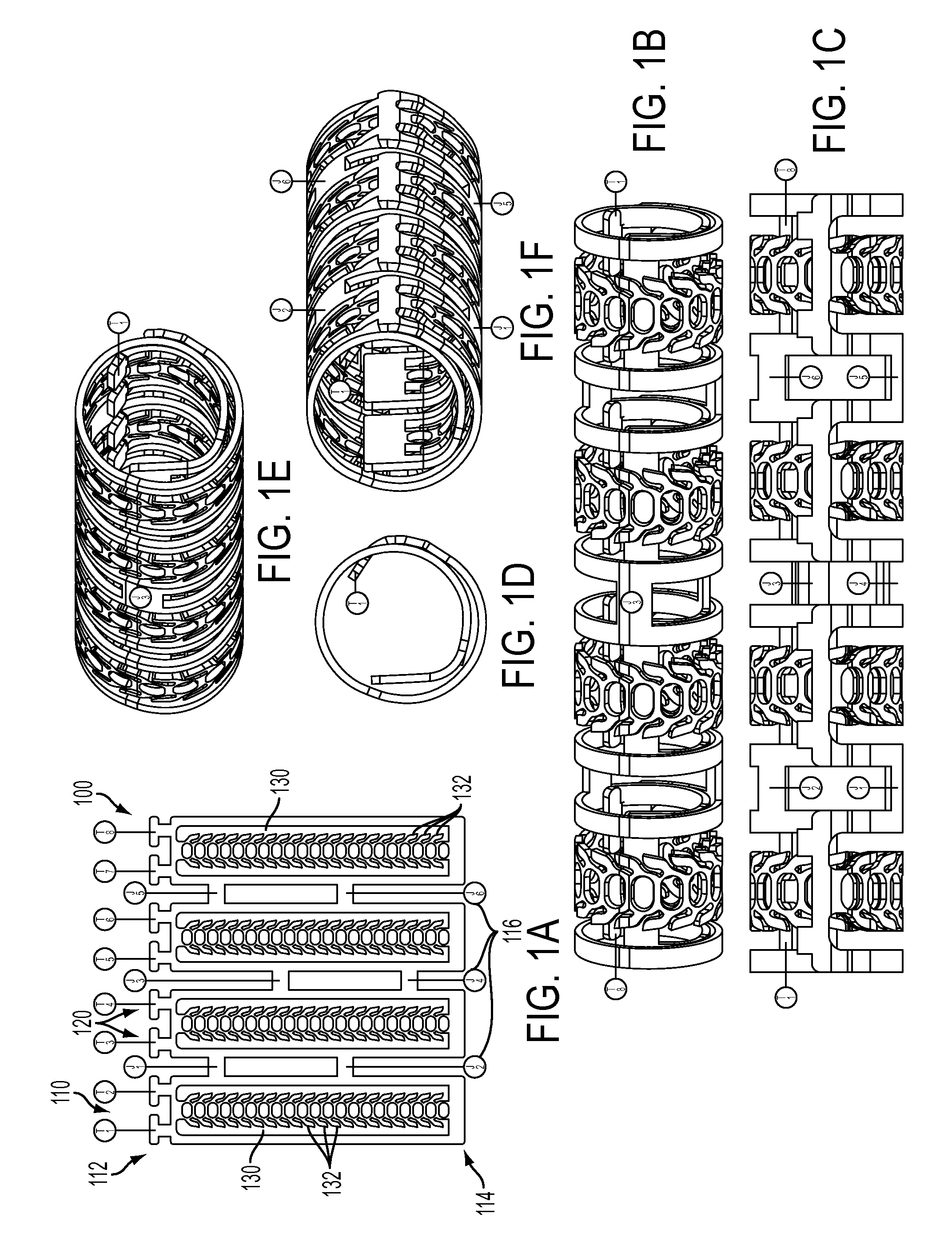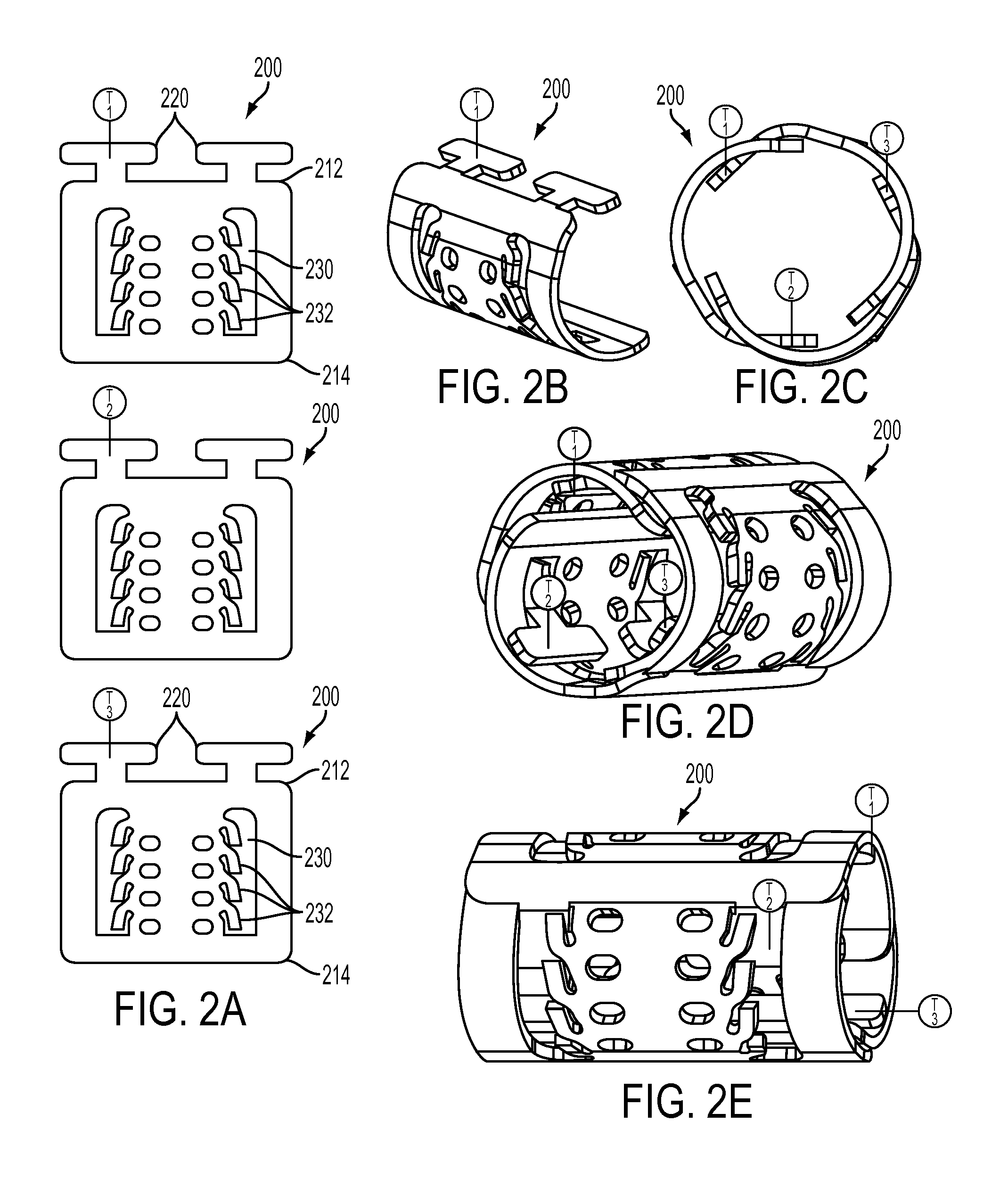Bioresorbable biopolymer stent
- Summary
- Abstract
- Description
- Claims
- Application Information
AI Technical Summary
Benefits of technology
Problems solved by technology
Method used
Image
Examples
first embodiment
[0041]FIGS. 1A-1F show a ratcheting polymer stent 100 according to the invention. The stent 100 can include one or more stent elements 110, for example, FIGS. 1A-1F show four stent elements 110, each being connected or joint to one or more adjacent stent elements 110 by a joint 116. The joints 116 can be cut to enable the axial length of the stent 100 to be reduced. Each stent element 110 can include a first end 112 and a second end 114. The first end 112 can include one or more tabs 120 that are adapted to fit into slots 130. The slots 130 can extend from the second end 114 toward the first end 112 and while the figure shows the slot 130 extending all the way to the first end 112, the slot can end before reaching the first end 112, for example, ending in the middle of the device. The slot 130 can also include one or more teeth 132 that interact with tab 120 to control the diameter of the stent 100. The teeth 132 can be configured with an angled surface that allows the tab 120 to mo...
second embodiment
[0044]FIGS. 2A-2E show a ratcheting polymer stent 200 according to the invention. The stent 200 can be formed by combining two or more stent elements 210 in an end to end configuration as shown in FIGS. 2B-2E. While these figures show three, relatively short stent elements 210 connected end to end for form a hollow tube more stent elements 210 can be used to produce a larger diameter stent 200 and longer stent elements 210 can be used to enable larger variations in expanded stent diameter. Stent elements 210 of differing lengths can be used together. In this embodiment, each stent element 210 can be similar in the stent elements 110 shown in FIGS. 1A-1F. Thus each stent element 210 can include a first end 212 and a second end 214, the first end 212 can include one or more tabs 220 that are adapted to fit into slots 230. The slots 230 extend from the second end 214 toward the first end 212 and while the figure shows the slot 230 extending all the way to the first end 212, the slot ca...
third embodiment
[0047]FIGS. 3A-3C show a ratcheting polymer stent 300 according to the invention. The stent 300 can include one or more stent elements 310, for example, FIGS. 3A and 3C show four stent elements 310, each being connected or joint to one or more adjacent stent elements 310 by a common side or joint 316. The joints 316 can be cut to enable the axial length of the stent 300 to be reduced. Each stent element 310 can include a first end 312 and a second end 314, and the first end 112 can include one or more tongues or strips 330 that are adapted to fit into slots 320. The strips 330 extend from first end 312 to the second end 314. The strip 330 can also include one or more teeth 332 that interact with slot 320 to control the diameter of the stent 300. The teeth 332 can be configured with an angled surface that allows the slot 320 to more easily slide past the teeth 332 in one direction (e.g. to increase in diameter) but resist movement in the opposite direction (e.g. to resist compressive...
PUM
| Property | Measurement | Unit |
|---|---|---|
| Fraction | aaaaa | aaaaa |
| Fraction | aaaaa | aaaaa |
| Time | aaaaa | aaaaa |
Abstract
Description
Claims
Application Information
 Login to View More
Login to View More - R&D
- Intellectual Property
- Life Sciences
- Materials
- Tech Scout
- Unparalleled Data Quality
- Higher Quality Content
- 60% Fewer Hallucinations
Browse by: Latest US Patents, China's latest patents, Technical Efficacy Thesaurus, Application Domain, Technology Topic, Popular Technical Reports.
© 2025 PatSnap. All rights reserved.Legal|Privacy policy|Modern Slavery Act Transparency Statement|Sitemap|About US| Contact US: help@patsnap.com



